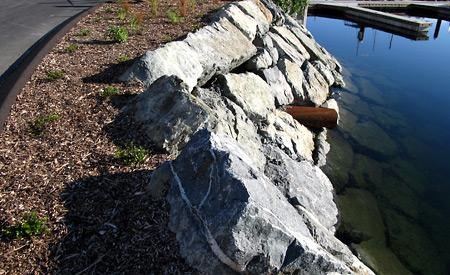Every now and again it rains here in Powell River. When it does, some of the drops fall on concrete, asphalt, parking lots and rooftops, impermeable surfaces. From there it runs into gutters and downspouts, into storm drains and sewers and eventually into the ocean.
On route, it picks up chemicals, garbage, solvents and insolvents, and during heavy rainfall, puts large amounts of energy into the sewer system occasionally sending raw sewage into Malaspina Strait.
Recently, developers have been asked to consider stormwater drainage before it hits the storm drains. They need to find ways of mitigating the amount of stormwater heading off the land, so that the amount is equal to that which would have been there before the development.
“If you develop a piece of property you can only discharge to the city system what your predevelopment flows were,” explained Frank D’Angio, City of Powell River engineering technologist. This means that if there is a large property currently with trees on it, the developer can only discharge the calculated volume of storm water equivalent to what the trees would absorb, he said. “You can’t add to it. You have to come up with ingenious ways of dealing with it.”
Around Powell River, ingenious solutions can be seen.
A pond retention system is installed on the development just beyond Powell River Academy of Music, on the south side of Kemano Street. This is a large catchment basin containing foliage and trees in a naturalized environment. When it rains, water runs off the adjacent development, into the basin, and is only able to drain into the storm sewer at a regulated rate. It also allows the vegetation to be nourished by the water and evapo-transpirate moisture back into the air.
The new development on Selkirk Avenue, accessed off Toba Street, has a rock garden to slow down water flow. By slowing the water down, pollutants are dropped. This is another benefit of storm water initiatives. The water going into the storm sewer is cleaner than it would be without the initiatives.
D’Angio points out the grass paving at the Wharf at Westview as a way to recharge the groundwater aquifer rather than allow water to drain directly into the ocean. The area has triple function: it maintains space for parking as vehicles can be parked on top of the specially selected grass; the paving is permeable so water can infiltrate the ground; and aesthetics are maintained.
The city’s “flagship” rain garden is found along the north harbour, between the wall of rip rap rock and the road. “We wanted to do a demonstration garden and fortunately we were able to do it down at the north harbour,” said D’Angio.
Being at the bottom of Westview, this area receives a great flow of surface water draining off impermeable surfaces. The rain garden captures the water and processes it through foliage, mulch, sand and gravel, drain rock and geotextile fabric, slowing it down and cleaning the pollutants before it enters a pipe and is discharged to the ocean.
Residential owners can create rain gardens on their own property. The gardens add beauty to any yard while retaining the integrity of the land. Canada Mortgage and Housing Corporation has a useful fact sheet, about the creation of rain gardens, on its website under the link Maintaining a Home, Landscaping. There are also many books on the subject.



